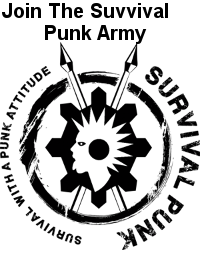10 Things You Must Have In a Bug-Out Bag
Today I have a guest post from Justin via the Food Insurance folks. The post is about ten items you must have in your Bug Out Bag. THough I have some different ideas on BOB philosophy, as should everyone, this is a good list and won’t steer you wrong. So I’ll hand it over to Justin.
10 Things You Must Have In a Bug-Out Bag
It is sad that we are not safe in our very homes anymore. This is especially true during natural disasters when we are forced to evacuate. In order to survive, we must prepare a bug-out bag which should contain the necessary items that will enable us to survive for at least 72 hours.

Bug-out Bag Tips
-
Keep it light. Remember that in times of emergency, you may have to carry your bug-out bag on your back. A too-heavy pack may pose as an obstacle to survival instead of an aid. On the other hand, if you pack it too light, you may not have everything that you need. The trick is to find a balance between these two by determining the items you really need.
-
Factor in local geography. For example, if you live in an area prone to flooding, you may want to make your bug-out bag waterproof.
-
Consider the personal needs of each family member. For example, if your son is asthmatic, be sure to pack his inhaler and other medications.
-
When your bug-out bag is complete, keep it in a place where you can grab it quickly when you have to leave the house immediately.
-
Check your bug-out bag regularly and replace expired food and batteries.
Basic Bug-out Bag Items:
-
Food. The first on the list is our basic source of nourishment. It is ideal to pack ready-to-eat meals since in most emergency situations you do not have the time to cook food.
-
Water. We need water more than food and to keep clean water handy is important especially when water supplies may be contaminated. If you can, grab some water purification tablets and learn basic water purifying methods.
-
Medical supplies. Simple first aid kits containing disinfectant and gauze, and treatment for colds, cough, and fever suffice for a proper bug-out bag.
-
Sleeping bags. Leaving our homes in times of disasters may be necessary, however difficult it may be. In order to prepare for that, we must have sleeping bags and rudimentary shelter material prepared in our bug-out bags.
-
Knife. Since we cannot carry everything in our packs, we must be able to improvise tools from our environment using our knives.
-
Firearm. This is our main defensive tool, though we must only use it when absolutely necessary.
-
Lighting devices. Expect power shortage during a disaster so we must have light sources ready that will enable us to move and locate things when it’s dark.
-
Map and compass. Along with these items, we should also have map-reading and navigation skills to help us evacuate a dangerous area and seek refuge.
-
Identification papers and other documents. Proper identification will enable us to get help and cross borders (if necessary) easily.
-
Radio. Conventional means of communication such as land and mobile phones might prove unreliable when disaster strikes.
The trickiest part in assembling a bug-out bag is food: we must pack items that are nutritious, filling, light and compact, and have a long shelf life. Failure to pack food wisely will most likely mean hunger and vulnerability to illness. If you have trouble choosing and preparing food for a bug-out bag, try Food Insurance. They have products that are designed to meet food storage needs.
About the author:
Justin is a target shooting enthusiast, avid outdoorsman, and freelance writer.
References:
“The ultimate bug-out bag revealed at shot show”; Allison Barrie; Fox News; January, 2013;
New York Times: What You’ll Need to Escape New York
“How to Build Your Own Urban Survival Bug-Out Bag”; Eric Rogell; Discovery News; April, 2012.;
10 Things You Must Have In a Bug-Out Bag
It is sad that we are not safe in our very homes anymore. This is especially true during natural disasters when we are forced to evacuate. In order to survive, we must prepare a bug-out bag which should contain the necessary items that will enable us to survive for at least 72 hours.
Bug-out Bag Tips
-
Keep it light. Remember that in times of emergency, you may have to carry your bug-out bag on your back. A too-heavy pack may pose as an obstacle to survival instead of an aid. On the other hand, if you pack it too light, you may not have everything that you need. The trick is to find a balance between these two by determining the items you really need.
-
Factor in local geography. For example, if you live in an area prone to flooding, you may want to make your bug-out bag waterproof.
-
Consider the personal needs of each family member. For example, if your son is asthmatic, be sure to pack his inhaler and other medications.
-
When your bug-out bag is complete, keep it in a place where you can grab it quickly when you have to leave the house immediately.
-
Check your bug-out bag regularly and replace expired food and batteries.
Basic Bug-out Bag Items:
-
Food. The first on the list is our basic source of nourishment. It is ideal to pack ready-to-eat meals since in most emergency situations you do not have the time to cook food.
-
Water. We need water more than food and to keep clean water handy is important especially when water supplies may be contaminated. If you can, grab some water purification tablets and learn basic water purifying methods.
-
Medical supplies. Simple first aid kits containing disinfectant and gauze, and treatment for colds, cough, and fever suffice for a proper bug-out bag.
-
Sleeping bags. Leaving our homes in times of disasters may be necessary, however difficult it may be. In order to prepare for that, we must have sleeping bags and rudimentary shelter material prepared in our bug-out bags.
-
Knife. Since we cannot carry everything in our packs, we must be able to improvise tools from our environment using our knives.
-
Firearm. This is our main defensive tool, though we must only use it when absolutely necessary.
-
Lighting devices. Expect power shortage during a disaster so we must have light sources ready that will enable us to move and locate things when it’s dark.
-
Map and compass. Along with these items, we should also have map-reading and navigation skills to help us evacuate a dangerous area and seek refuge.
-
Identification papers and other documents. Proper identification will enable us to get help and cross borders (if necessary) easily.
-
Radio. Conventional means of communication such as land and mobile phones might prove unreliable when disaster strikes.
The trickiest part in assembling a bug-out bag is food: we must pack items that are nutritious, filling, light and compact, and have a long shelf life. Failure to pack food wisely will most likely mean hunger and vulnerability to illness. If you have trouble choosing and preparing food for a bug-out bag, try Food Insurance. They have products that are designed to meet food storage needs.
About the author:
Justin is a target shooting enthusiast, avid outdoorsman, and freelance writer.
References:
“The ultimate bug-out bag revealed at shot”; Allison Barrie; Fox News; January, 2013;
[http://www.foxnews.com/tech/2013/01/17/ultimate-bug-out-bag-revealed-at-shot-show/]
New York Times: What You’ll Need to Escape New York;
[http://www.nytimes.com/interactive/2013/01/27/nyregion/preppers-bug-out-bag.html?_r=0]
“How to Build Your Own Urban Survival Bug-Out Bag”; Eric Rogell; Discovery News; April, 2012.;
[http://news.discovery.com/adventure/survival/how-to-build-your-own-urban-survival-bug-out-bag.htm]























Comments are closed.